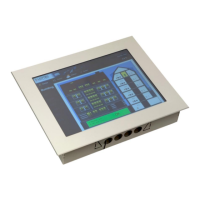L-VIS User Manual 147 LOYTEC
Version 6.2 LOYTEC electronics GmbH
MinSend: At least the specified amount of time has to pass between two
successive update messages on the network. If the device delivers mode updates
than this, intermediate values will not be sent out, until the minimum send time
has passed, at which time the current (most recent) value is sent out.
MaxSend: If this amount of time has passed without any updates, usually
because the value did not change in the meantime, then the current value will be
sent out. This is commonly described as a heartbeat function, used to allow the
receiver to detect if the sender is still alive and just not sending new information
because there is none, or if the sender has died and therefore no new data is
received.
PollTime: Can work as a simple poll interval, or as a receive timeout. Usually
used as receive timeout for bound NVs on CEA-709 devices and otherwise used
as poll cycle time. If used as a receive timeout, it specifies the amount of time
after which the device sends out a poll request, if no value update was received.
As a poll cycle, it specifies the amount of time after which a periodic poll request
should be sent out, independent of any updates which might have been received
in the meantime.
9.6.2 System Startup
Note that the data point update flag System Startup is independent of the flag Poll on
Startup, which may be available for certain network technologies such as CEA709. The
two options are related to different functions and do different things:
The System Startup update flag can be set for input as well as output direction:
o Input: Causes the object to which the data point is connected, like for
example a control, action, math object, or trigger, to receive an initial
value update after device boot up. This update may come from a default
value, a persistent value, or a value already received from the network
while the system was booting. For data points representing a normal
value like a temperature, this option is usually turned on, such that the
display shows current information. For data points representing events
which can trigger actions, this is usually not desired and turned off.
o Output: For outputs, this function is not desired in almost all cases,
since it would trigger an outgoing value update whenever the device
starts. It may be useful to trigger actions during system start, for
example to send a status mail, record the last boot time in a register or
data log, or to switch to a certain page.
The Poll on Startup function is located in the properties of the referenced data
source and is only available on input or value data points. The option requests
that a poll message be sent out on the network to query a remote device for the
current value. If this is possible at all, or if a current value is automatically
received in the course of establishing communication with the remote device, is
dependent on the underlying network technology. For example, if the polled flag
of an input network variable is not set, the device will not be able to fetch the
current value from the sender, since it has no knowledge of the senders network
address and therefore cannot send a request for a value update.

